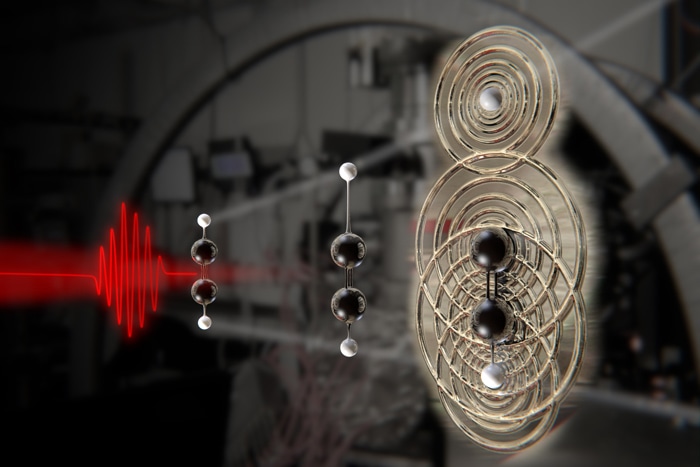Dec 16 2016
 (Credit: http://www.upc.edu/)
(Credit: http://www.upc.edu/)
Researchers can now directly track the locations of all the atoms of an entire molecule while one of its bonds breaks and a single proton escapes.
Imagine what it would be like to watch the DNA compounds move, rearrange, and replicate, or see how the individual atoms of molecules form a novel substance by rearranging themselves during a chemical reaction. Such capabilities may provide unparalleled insight for understanding and possibly controlling the processes.
Until now, the fundamental idea of watching the way molecules transform or break during chemical reactions has been unconceivable, as all of the atoms of a molecule have to be tracked with a sub-atomic spatial resolution combined with a temporal resolution of a few femtoseconds.
Watching a molecular reaction by taking such “snapshots” with an integrated spatiotemporal resolution was believed to be a topic for science fiction.
Precisely two decades ago, it was proposed that the molecule’s own electrons can be used to image its structure - teaching the molecule to take a selfie. While this concept was brilliant, it was not possible to implement, until now.
Scientists from the Attoscience and Ultrafast Optics Group of the Institute of Photonic Sciences (ICFO), in association with researchers from the Netherlands, the USA, Germany and Denmark, reported on imaging the breakup of a molecular bond in acetylene (C2H2) nine femtoseconds (1 femtosecond = 1 millionth of a billionth of a second) following its ionization. The study has been reported in Science.
The researchers were able to track the individual atoms of the isolated acetylene molecule with a temporal resolution of 0.6 femtoseconds and a spatial resolution down to 0.05 Ångström (less than the width of an individual atom). In addition, the team successfully triggered the breakup of one of the bonds of the molecule and observed how a single proton exits the molecule.
Our method has finally achieved the required space and time resolution to take snapshots of molecular dynamics without missing any of its events, and we are eager to try it out on other molecular systems such as chemical catalysts and bio-relevant systems.
Jens Biegert, Catalan Institution for Research and Advanced Studies professor at ICFO
Teaching a Molecule to Take a Selfie
The researchers created a unique, ultrafast mid‐IR laser source and integrated it with a reaction microscope to locate the 3D momentum distribution of ions and electrons in full kinematic coincidence. During the experiment, a short laser pulse was used to orient an isolated acetylene molecule in space. An adequately strong infrared follow-up pulse released a single electron from the molecule, expedited it on a return trajectory, and pushed it to scatter off its own parent molecular ion, all within 9 femtoseconds.
Benjamin Wolter explained, “the flight path and kinetic energy of all collision fragments were recorded with the reaction microscope, as in a big particle physics experiment.”
The researchers did some ingenious data processing and successfully extracted the entire molecular structure, demonstrating that orienting the molecule along the laser’s electric field or perpendicular to it fully changed its dynamics. In one case, a C-H bond was clearly broken, while in the other case, the molecule experienced vibrational motion with the laser field.
The experiment provided the first direct observation of the proton and visualization of bond cleavage during its departure from the [C2H2]2+ ion.
We took one electron, steered it along a specific path with the laser and scattered it off an isolated molecule to record its diffraction pattern. It is mind‐boggling to imagine the length and time scales of the experiment.
Jens Biegert, Catalan Institution for Research and Advanced Studies professor at ICFO
This feat was achieved through the remarkable collaboration between theorists and experimentalists, quantum chemists and atomic physicists from Kansas State University, ICFO, the Max-Planck-Institut für Kernphysik, the Center for Free Electron Laser Science/DESY/CUI, the Physikalisch Technische Bundesanstalt, Friedrich‐Schiller University Jena, Aarhus University, Universität Kassel, and Leiden University.